BECKHOFF DK9222-0311-0029 User Manual
Fast communication with the dmx protocol

I/O
Light
Application Note DK9222-0311-0029
Keywords
EL6851
DMX
DMX512A
RS485
Show technology
Lighting
LED
Lighting control
Lighting technology
Master
Slave
XLR
Light
Stage
Show
Fast communication with the DMX protocol
This application example describes DMX – a standard transmission protocol for lighting technology
– and the Beckhoff DMX EtherCAT terminals EL6581 (- 0000: master, -0010: slave), with which the PC- and
EtherCAT-based control technology can be used for show, stage, special effects and drama applications.
DMX
DMX is the standard protocol for controlling professional stage and lighting effects equipment, which is used, for example, in
the dynamic lighting of showrooms and salesrooms as well as for exclusive displays of light and color in high-profile buildings,
such as hotels and event centers. As the bus system used in professional lighting technology, DMX works with RS485 physics.
DMX stands for ‘Digital Multiplexing’ and enables serial data transmission with a data rate of 250 kbit/s. Color mix and
brightness values are transmitted to DMX slaves in the form of static light sources (e.g. spotlights). In the case of moving
light sources (e.g. moving heads and scanners), angles for pan/tilt and motion profiles stored in the device are additionally
communicated. The topology configuration corresponds to daisy chain cabling (all slaves in a ‘universe’ in series); therefore, the
slaves have an input and an output port. Three-pole XLR plugs are used for cabling.
Dimmer
Color changer
Moving Head
Scanner
LED
color changer
Stroboscope
Fig. 1 Typical DMX slave devices
New Automation Technology
BECKHOFF
1
For application notes see disclaimer on the last page
